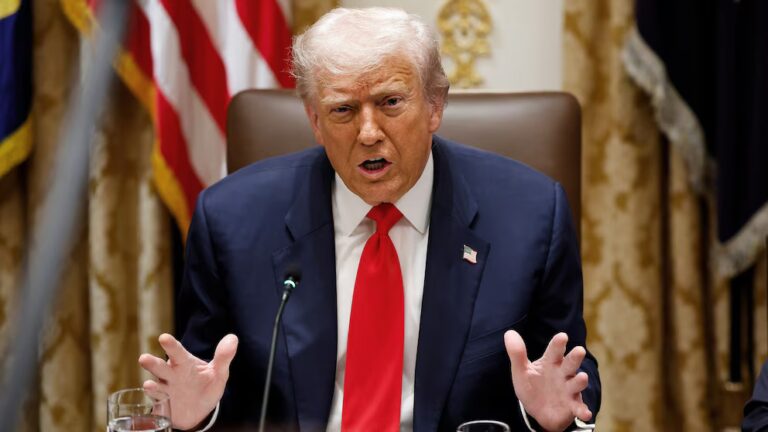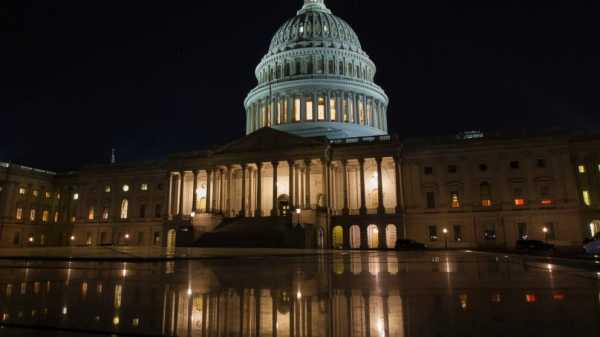
President Donald Trump’s administration is about to make it easier for companies to build pipelines, bridges, and roads without an environmental review — opening the door to projects that could pollute the US and accelerate climate change.
The proposed rule, first reported by the New York Times and announced by Trump Thursday, would be the biggest deregulatory change to the 50-year-old National Environmental Policy Act in nearly three decades. Currently, all major federal construction projects must undergo a mandatory review, or environmental impact statement, if they’re expected to have major effects on the surrounding ecosystem. However, the new standard would create a new “non-major” project category, allowing smaller federal infrastructure projects to begin construction without a review.
Trump’s administration — which has waged a widespread campaign to roll back environmental regulations and protections — had hinted this was coming.
“While the goals of NEPA remain the same as they did 50 years ago, the environmental review process designed to improve decision making has become increasingly complex and difficult to navigate,” the White House said in a January 1 statement on the landmark legislation’s anniversary.
Industry organizations, such as the American Petroleum Institute, the US Chamber of Commerce, and several transportation groups, had been seeking such a change for years. Many of them complained in a November letter to Mary Neumayr, chair of the Council on Environmental Quality, about the lengthy environmental review process, which they contended currently takes an average of almost six years and can produce reports that encompass hundreds of pages — a message that resonated with the Trump administration.
Announcing the change Thursday, Trump said too many projects are “tied up and bogged down by an outrageously slow and burdensome federal approval process.” Under the proposal, reports will now be subject to page limits and must be completed within two years.
However, the rule’s broad language may allow for some large construction projects to skip a review.
According to the New York Times, one administration official familiar with the changes said there will be no set dollar figure for separating major from non-major projects, which could open the door for “major mining, drilling and other projects to avoid environmental assessments.”
The proposed rule also does not mention climate change but could pose problems for federal agencies’ efforts to combat it, according to the Times report:
And not only will they not have to account for a project’s impact on climate change, but agencies also won’t have to examine whether rising sea levels or other effects of climate change will compromise a bridge or road’s safety in the future.
Trump’s attacks on the environment
Thursday’s announced rule change is just the latest in the Trump administration’s years of assault on environmental regulations. Despite vague campaign promises to “promote clean air and water,” the New York Times has identified 58 separate rules rolling back environmental protections that have completed the administrative process, and 37 more that are still in the works.
The rollbacks span across the environmental spectrum, from clean air and water rules, to loosening regulations governing oil and gas extraction, to wildlife protections. And the president, long a climate change skeptic, is taking the steps to fulfill a campaign promise to withdraw from the Paris climate accords.
Last month, Trump ordered an administrative review of the Environmental Protection Agency’s WaterSense program, which encourages use of low-flow bathroom fixtures such as toilets and showers. “People are flushing toilets 10 times, 15 times as opposed to once. They end up using more water,” Trump said at the time.
The quality of air and water in the US is mixed, with lead contamination and air pollution of increasing concern to scientists. Trump, however, has done little to address these issues, and began unraveling the environmental protections put in place by his predecessors almost immediately after assuming office, as Vox’s Matthew Yglesias has explained:
Democratic-controlled state governments and environmental advocates have turned to the courts to fight back against the administration’s loosening regulatory agenda. In August last year, more than 20 states sued the EPA over a rollback of climate change rules for power plants. In September, 22 Democratic states sued the National Highway Traffic Safety Administration, a division within the Department of Transportation, over a rule that revoked states’ rights to set their own vehicle emissions standards.
A similar fate could be in store for the administration’s latest proposed rule. The Environmental Protection Act requires that all federal projects undergo an environmental impact study, and it’s unclear whether that portion of the law can be changed by administrative fiat. “A regulation can’t change the requirements of a statute as interpreted by the courts,” Richard Revesz, a professor of environmental law at New York University, told the Times.
In fact, he said that the loosened regulations could lead to more lawsuits against individual infrastructure and energy projects, which could exacerbate the long construction delays the proposed rule seeks to bring to an end.
Sourse: vox.com






